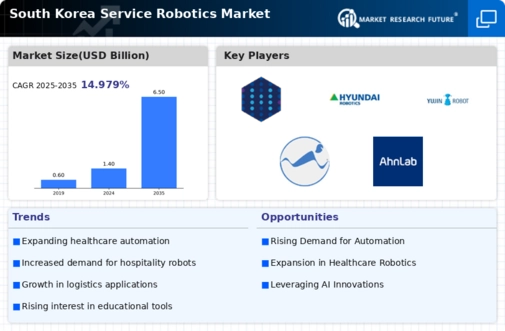The South Korea Service Robotics Market has witnessed significant growth, driven by advancements in technology, increasing automation demands, and a growing focus on enhancing operational efficiency across various sectors. This market is characterized by a diverse array of companies that are continually innovating and striving to establish strong market positions by capitalizing on emerging opportunities in service robotics. These companies compete on various fronts, including technology integration, customer service, product offerings, and strategic partnerships, which are pivotal in defining their competitive edge.
The increase in service-oriented robotics solutions that cater to various applications, including healthcare, hospitality, and logistics, has intensified competition amongst key players, making it crucial for organizations to evolve and adapt to changing market dynamics.H Robotics has established a formidable presence within the South Korea Service Robotics Market through its commitment to innovation and high-quality robotic solutions optimized for diverse applications. The company specializes in delivering service robots that cater to sectors such as healthcare and education, leveraging advanced technologies to enhance user experience and operational effectiveness.
H Robotics is known for its agility in responding to market demands, allowing it to quickly adapt its products to meet evolving customer needs. The company cultivates strong partnerships within the industry, ensuring that it stays at the forefront of technological advancements.
This strategic positioning enables H Robotics to maintain a competitive advantage and address specific challenges faced by end-users in the service robotics sector.Hyundai Robotics plays a significant role in shaping the South Korea Service Robotics Market with its comprehensive range of robotic products and services that cater to various industries. With a robust market presence, Hyundai Robotics is well-established in the service robotics landscape, known for providing innovative solutions that integrate artificial intelligence and automation technologies. Its key offerings encompass service robots tailored for logistics, manufacturing, and healthcare applications, showcasing the company’s commitment to enhancing operational efficiencies.
Hyundai Robotics has also strengthened its market position through strategic mergers and acquisitions, enabling it to expand its portfolio and enhance its technological capabilities. Furthermore, the company’s focus on research and development facilitates the continuous improvement and innovation of its robotic solutions, thereby reinforcing its strengths in the competitive landscape of South Korea’s service robotics market.















Leave a Comment